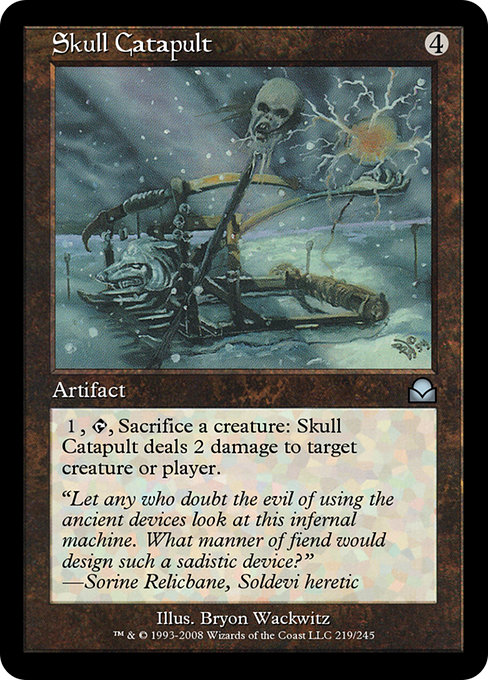
Image courtesy of Scryfall.com
Skull Catapult's Recurring Characters in MTG Lore
When you talk about artifacts that feel like living relics from the tabletop’s dusty corners, Skull Catapult stands tall—an artifact from Masters Edition II that embodies a certain old-world engineering vibe. For a card that reads simply as "{1}, {T}, Sacrifice a creature: This artifact deals 2 damage to any target," there’s a surprisingly rich undercurrent of lore and recurring personalities that fans love to spotlight. The Me2 edition itself is a curated bridge to the past, reprinting a card that embodies the era’s fascination with contraptions, cemeteries of relics, and the perils of awakening ancient devices. And behind its simple mechanic lies a flavor that invites fans to lean in, listen for whispers from the past, and imagine the faces that haunted the workshop where such devices were conjured 🧙♂️🔥.
Sorine Relicbane: The Soldevi Voice in the Machine
At the core of Skull Catapult’s lore is a single, piercing line of flavor that makes the artifact sing in fan discussions: Sorine Relicbane, labeled a Soldevi heretic, speaks of the danger and moral weight of using ancient devices. The flavor text—“Let any who doubt the evil of using the ancient devices look at this infernal machine. What manner of fiend would design such a sadistic device?”—is not just wordplay. It positions Sorine Relicbane as a recurring conscience within the artifact-driven storylines of the era. The Soldevi identity itself—rooted in a faction renowned for relics, runes, and the relentless pursuit (and regulation) of ancient tech—gives Skull Catapult a seat at a broader table of recurring characters who appear across cards and narrative passages. Sorine’s warning and critique pop up like a familiar chorus whenever players lean into artifact-centric strategies, reminding us that power in the Magic multiverse often carries a price tag that’s more than mana 💎⚔️.
Let any who doubt the evil of using the ancient devices look at this infernal machine. What manner of fiend would design such a sadistic device? — Sorine Relicbane, Soldevi heretic
Other Recurring Faces in the Artifact-Driven Lore
- Soldevi Clerics and Relic-Hunters: Skull Catapult belongs to a lineage of artifacts that attract the attention of priests who debate the ethics of reactivating old engines and relics. The recurring Soldevi motif—clerics who invoke ritual safeguards and relic-hunters who chase forgotten tech—frames a larger conversation in MTG lore about power, memory, and control over dangerous tools.
- Artifact Engineers and Custodians: Beyond individual names, a cadre of engineers, artificers, and custodians repeatedly appear around legendary machines that seem to hum with their own will. They’re not always celebrated in the flavor text, but they show up in stories where cities and campaigns—whether in Legends-era fiction or modern retellings—grapple with whether such devices belong in the present or should be sealed away in history.
- The broader Legacy of Legends and Masters Sets: Skull Catapult, printed in Masters Edition II (a set steeped in Legends-era nostalgia), deliberately evokes the long arc of artifact-centric cards. The recurring characters you’ll note aren’t just people but archetypes—maverick researchers, wary priests, and relic-smiths—who recur whenever the game leans into the dark glow of ancient machinery. The flavor text existence of Sorine Relicbane cements this as a character who serves as a moral counterweight to the machine’s cold efficiency 🧙♂️🎨.
The Card in Play: How Recurring Characters Shape Skulls and Swords
Skull Catapult’s blend of colorless mana and a creature-sacrifice trigger taps into a timeless niche within MTG: the dance between life, death, and fiery consequence. The recurring characters in this niche aren’t just voices in a story; they’re tools for deckbuilding storytelling. If you embed Skull Catapult in a deck that wants repeated sacrifice fodder—whether through token generators, sacrifice outlets, or ETB/death-bath synergy—the lore-heavy flavor becomes your narrative engine. It’s not merely about pinging a single target; it’s about feeling like you’re reactivating a forgotten engine under the watchful gaze of Sorine Relicbane and her peers. The tension between using such devices and the cautionary voices in the lore adds a delightful depth to the matchup dance, whether you’re on the battlefield or just reminiscing about the art and flavor that helped define Masters Edition II 🧙♂️🔥.
Of course, Skull Catapult’s own text is lean, efficient, and classic: pay a small cost (one generic mana), tap, sacrifice a creature, deal two damage to any target. That efficiency mirrors the era’s fascination with “old tech” that punches above its apparent grade. Every time you tap Skull Catapult, you’re not just dealing damage; you’re reviving a little corner of MTG history and inviting the recurring characters to observe how their worries about the devices translate into actual board impact. The card’s uncommon status in Masters Edition II hints at its rarity within a reprint environment that loves to tuck away these tiny, potent machines with big implications 🧩.
From Lore to Deckbuilding: Bringing It Home
For players who adore lore-forward decks, Skull Catapult offers a touchstone. It’s a vehicle to celebrate the recurring characters who shape MTG’s artifact-heavy chapters while also delivering a practical payoff on the battlefield. The flavor text invites you to imagine Sorine Relicbane glancing over the battlefield’s smoky haze, wary of the device’s glow, and perhaps muttering a cautious, almost affectionate warning to keep in mind that even a small artifact can reshape a game’s story. That duality—storytelling flair and tactical utility—drives a personalized, immersive experience that fans chase as eagerly as the next legendary creature drop 🧙♂️🎲.
And if you’re looking to keep your desk as evocative as your deck, a little cross-promotion never hurts. A sleek Neon Gaming Rectangular Mouse Pad can keep your work area as sharp as Skull Catapult’s edge, a perfect companion for late-night brainstorms about artifact synergies and lore-laden card choices. It’s the kind of product collaboration that echoes the MTG ethos: blending fantasy, function, and a touch of old-school flavor in a way that feels inevitable—and totally you 🔥💎.